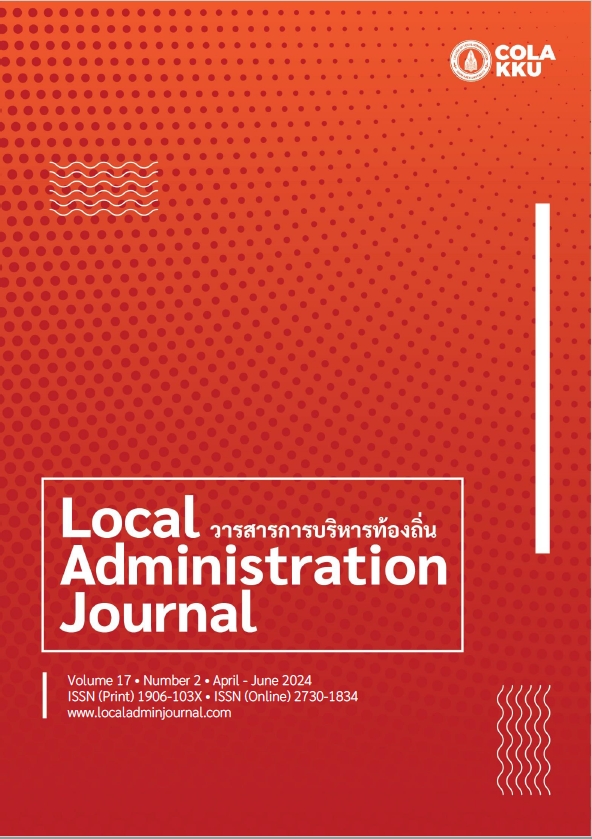สานพลัง เปิด “พื้นที่กลาง” สร้างสุขสุพรรณ : แนวทางการพัฒนาคุณภาพชีวิตถ้วนหน้าในจังหวัดสุพรรณบุรี
คำสำคัญ:
พื้นที่กลาง, ประชาธิปไตยแบบปรึกษาหารือ, ประชาธิปไตยแบบมีส่วนร่วม, ชุมชนเข้มแข็งบทคัดย่อ
พื้นที่กลาง คือ หัวใจสำคัญของระบอบประชาธิปไตยแบบปรึกษาหารือที่พยายามแก้ไขข้อบกพร่องของประชาธิปไตยแบบตัวแทน พื้นที่กลางตั้งอยู่ระหว่างรัฐและสังคม ช่วยสร้างสมดุลระหว่างเสถียรภาพและการเปลี่ยนแปลงทางสังคม เป็นเวทีที่เปิดโอกาสให้มีการอภิปราย ถกเถียงประเด็นสาธารณะ หรือตรวจสอบการทำงานของรัฐ เป็นพื้นที่ของการตัดสินใจทางการเมืองที่ใช้ความคิดร่วมกันของทุกภาคส่วนสร้างผลลัพธ์ที่ผ่านการตัดสินใจบนพื้นฐานของประโยชน์ส่วนรวม โครงการวิจัยเชิงปฏิบัติการ “นวัตกรรมทางสังคมเพื่อสร้างชุมชนเข้มแข็ง : พื้นฐานของประชาธิปไตยอัตลักษณ์ไทย” ใช้กระบวนการวิจัยเชิงปฏิบัติการแบบมีส่วนร่วม เน้นกระบวนการร่วมเรียนรู้ ร่วมขับเคลื่อน และร่วมถอดบทเรียน ระหว่างคณะผู้วิจัย องค์กรชุมชนระดับจังหวัดนำร่อง สถาบันพัฒนาองค์กรชุมชน และองค์กรสนับสนุนการพัฒนา ตลอดจนผู้มีส่วนเกี่ยวข้องทุกภาคส่วน เพื่อให้เกิดกระบวนการสร้างเสริมชุมชนเข้มแข็ง ผลักดันให้มีเวทีกลางของชุมชน ผู้วิจัยได้พิจารณาคัดเลือกชุมชนที่มีความพร้อมเป็นพื้นที่นำร่อง 5 จังหวัด โดยบทความฉบับนี้จะนำเสนอผลการดำเนินการในช่วงปีที่ 1 ของพื้นที่จังหวัดสุพรรณบุรี จากที่คณะผู้วิจัยได้เข้าร่วมเวทีกลางแลกเปลี่ยนความคิดเห็นและปรึกษาหารือของเครือข่ายขบวนองค์กรชุมชน ผู้นำสภาองค์กรชุมชนและภาคประชาสังคม ได้เปิดพื้นที่กลางโดยร่วมกันกำหนดเป้าหมายการพัฒนา ภายใต้แนวคิด “ดาวดวงเดียว” โดยคัดเลือกประเด็นความต้องการเร่งด่วนของประชาชนในจังหวัดสุพรรณบุรีเป็นประเด็นนำร่อง โดยเน้นไปที่การพัฒนาคุณภาพชีวิตทั้ง 5 ด้าน ประกอบด้วย ด้านเศรษฐกิจ ด้านสุขภาพ ด้านการศึกษา ด้านสวัสดิการ และด้านที่พักอาศัย อีกทั้งมีการขับเคลื่อนพื้นที่ระดับตำบลนำร่อง ที่ตำบลบ้านแหลมพัฒนา อำเภอบางปลาม้า เพื่อจัดทำแผนพัฒนาคุณภาพชีวิตระดับตำบลเป็นต้นแบบของพื้นที่อื่น ๆ ต่อไป
เอกสารอ้างอิง
Alinsky, S. (1989). Rules for radicals: A pragmatic primer for realistic radicals. New York, NY: Vintage.
Bramley, G., & Power, S. (2009). Urban form and social sustainability: The role of density and housing type. Environment and Planning B: Planning and Design, 36(1), 30-48.
Brown, R. B., Xu, X., Barfield, M. A., & King, B. G. (2000). Community experience and the conceptual distinctness of rural community attachment and satisfaction. Research in Community Sociology, 10, 421-446.
Castells, M. (2008). The new public sphere: Global civil society, communication networks, and global governance. The Annals of the American Academy of Political and Social Science, 616(1), 78-93.
Cope, M. R., Flaherty, J., Young, K. D., & Brown, R. B. (2015). Olympic boomtown: The social impacts of a one-time mega-event in Utah's Heber Valley. Sociological Spectrum, 35(2), 136-160.
Eizenberg, E., & Jabareen, Y. (2017). Social sustainability: A new conceptual framework. Sustainability, 9(1), 68.
Goodsell, T. L., Flaherty, J., & Brown, R. B. (2010). Community as moral proximity: Theorizing community in a global economy. Rural America in a Globalizing World: Problems and Prospects for the, 626-641.
Habermas, J. (1996). Between facts and norms: Contributions to a discourse theory of law and democracy. John Wiley & Sons.
Habermas, J. (2020). The public sphere: An encyclopedia article. In Critical Theory and Society (pp. 136-142). Routledge.
Habermas, J. (1991). The structural transformation of the public sphere: An inquiry into a category of bourgeois society. MIT Press.
Isariyanon, M., Isariyanon, S., & Silakorn, S. (2021). Community development of community strength to self-organization community of Thung Pho Sub-district, Na Di District, Prachin Buri Province. Nakhon Lampang Buddhist College’s Journal, 10(2), 15–30. (in Thai)
Ismail, M. (2009). Corporate social responsibility and its role in community development: An international perspective. Journal of International Social Research, 2(9), 199-209.
Kaewthep, K. (1995). Working in a community cultural way with human beings at the center. Catholic Council of Thailand for Development. (in Thai)
Kleinstüber, H. J. (2001). Habermas and the public sphere: From a German to a European perspective. Javnost - The Public, 8(1), 95-108.
Phillips, R., & Pittman, R. (2008). An introduction to community development. New York, NY: Routledge.
Promgird, P. (2013). Political sociology. Faculty of Humanities and Social Sciences, Khon Kaen University. (in Thai)
Samukkethum, S. (2015). Community, individuality, and development in the globalization era. Journal of Social Development and Management Strategy, 17(1), 1–27. (in Thai)
Samukkethum, S. (2023). Community empowerment and sustainable development. National Institute of Development Administration. (in Thai)
Sommerfeldt, E. J. (2013). The civility of social capital: Public relations in the public sphere, civil society, and democracy. Public Relations Review, 39(4), 280-297.
Suphanburi Provincial Statistical Office. (2021). Suphan Buri provincial statistical report: 2021. Suphanburi, Thailand: Suphan Buri Provincial Statistical Office. (in Thai)
ดาวน์โหลด
เผยแพร่แล้ว
รูปแบบการอ้างอิง
ฉบับ
ประเภทบทความ
สัญญาอนุญาต
ลิขสิทธิ์ (c) 2024 วารสารการบริหารท้องถิ่น

อนุญาตภายใต้เงื่อนไข Creative Commons Attribution-NonCommercial-NoDerivatives 4.0 International License.
บทความทุกเรื่องที่ได้รับการตีพิมพ์ทั้งรูปเล่มและบทความออนไลน์ เป็นลิขสิทธิ์ของวิทยาลัยการปกครองท้องถิ่น มหาวิทยาลัยขอนแก่น



